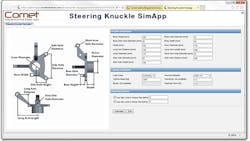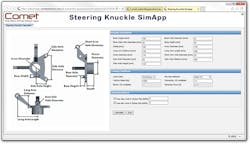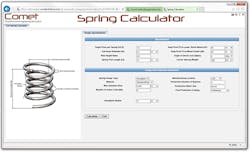Leveraging Simulation and Analysis Expertise
This file type includes high resolution graphics and schematics when applicable.
Imagine leveraging the expertise of senior analysts throughout the product-development team. The result would be accelerated new design validation delivering measurable improvements to innovation, development time, and related product quality.
Simulation Applications (SimApps), from Comet Solutions, is a new application trying to capture and extend this expert knowledge. It uses a software approach based—not on custom programming—but rather on the rapid graphical creation of robust templates. These templates would work across highly varying designs and even across an entire product family.
SimApps
Solution-specific SimApps are targeted applications that drive complex simulation templates. In-house analysis experts set up project templates that capture their expertise and your company’s standards in a highly reusable form. By embedding expert knowledge and removing 95% of the complexity of general-purpose CAE tools, SimApps allow non-experts to safely and quickly evaluate designs using simulations. With potentially more simulation users beyond just CAE experts, product teams could very well implement simulation-driven design.
“Extending simulation across the entire product-development team is critical for today’s compressed product-development cycles,” says Malcolm Panthaki, Chief Technology Officer for Comet Solutions. “When it takes days or weeks of experts’ time to analyze a single design iteration, it is hardly surprising that CAE continues to have a limited impact. The faster and more automatically new designs can be analyzed, the more alternatives can be considered.”
SimApps’ design check allows the user to quickly analyze designs by indicating which to reject and why, reducing the need for expensive and time-consuming physical tests. Today, organizations have access to essentially unlimited computing resources on cloud servers. Having to manually create each model for analysis is an impediment to rapidly exploring the design space, especially upfront.
Measurable Results
As an example, American Axle Manufacturing reports the following major benefits from SimApps for automated NVH analysis of driveline systems—only the first phase of a multi-phase, multi-year expansion of the use of SimApps throughout their global organization.
• Average 75% time reduction for each analysis iteration.
• Approximately $130,000 in annual cost savings at a single engineering site.
• Improved quality through globally enforced standards that help remove human error.
• Ability to run many more analysis iterations, leading to better design decisions earlier in the process.
• Ability to redeploy resources, as less-experienced engineers are now able to safely run sophisticated simulations.
Power to the Team
“Simulation has been the exclusive domain of too few for too long,” concludes Panthaki. “It’s time to put to rest the notion that simulation cannot be safely used unless you have deep expertise in the art of extracting reasonable results from today’s general-purpose simulation software.”
Due to the increase of cloud servers and the Internet of Things technology, product development hinges on collaboration and the rapid exploration of the design space at all levels of fidelity. The cloud-based approach allows companies to unify the work of disparate departments, suppliers, and partners while maintaining control and ensuring that standards will be enforced and consistently maintained, and that analysis results can be trusted. Salesmen, systems engineers, design engineers, and junior engineers will have equal access to the information, allowing for cohesive design practices.
While this cultural shift may be difficult for some organizations, it delivers tremendous benefits. The confluence of simulation methodologies, software, automation templates, and accessible computing hardware, aided by the advent of mobile devices with ubiquitous high-bandwidth access to the Internet, has the potential to magnify the number of users of simulation over the next decade.



